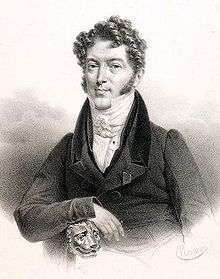Charles Philippe Lafont
Charles Philippe Lafont (1 December 1781 – 23 August 1839) was a French violinist and composer. He has been characterized as one of the most eminent violinists of the French school.[1]

Portrait by Pierre-Roch Vigneron.
Biography
Born in Paris, he received his first lessons from his mother. He later studied with Rodolphe Kreutzer and Pierre Rode. His teachers taught him the classical technique of the Viotti school, which he made more brilliant.[2]
As early as 1792 he toured Germany and other parts of Europe giving successful concerts. On the outbreak of the French Revolution, he left France, travelling through Europe. In 1808, he became chamber violinist to Tsar Alexander I of Russia. In 1815, he returned to France to become first violinist of the royal chamber musicians of Louis XVIII of France and musical accompanist to the Duchess of Berry. In 1816, he participated in a contest with Niccolò Paganini, in which neither won. However, the contest was held in La Scala, where the audience was more sympathetic to Paganini.
Few of his compositions have survived. In c. 1837, Franz Liszt wrote a Grand Duo concertant sur la Romance de M. Lafont "Le Marin", for violin and piano, S. 128 (revised c. 1849).[3] He was also a singer, but he is mostly remembered as a virtuoso violinist.
He died in an accident in 1839, when a carriage transporting him overturned.
Notes
- See Family Tree, under External links
- See biography under External links
- Grove's Dictionary of Music. 5th ed, 1954., Liszt: Works, p. 276
References
- Material from the external links below
External links
- www.closelinks.com Free Family Tree
- "Charles Philippe Lafont". The Concise Grove Dictionary of Music and Musicians. Retrieved December 3, 2007.
- . New International Encyclopedia. 1905.
- Free scores by Charles Philippe Lafont at the International Music Score Library Project (IMSLP)